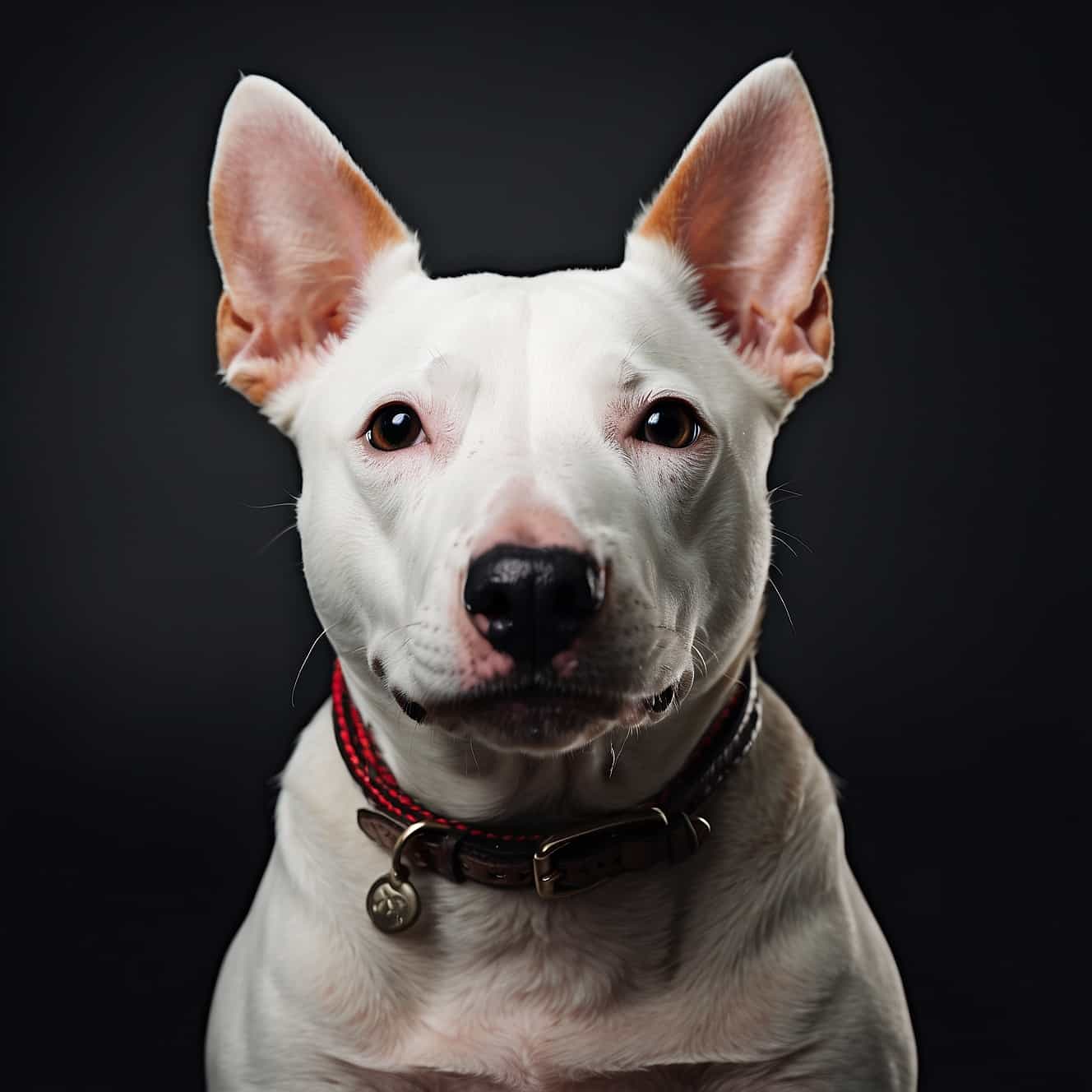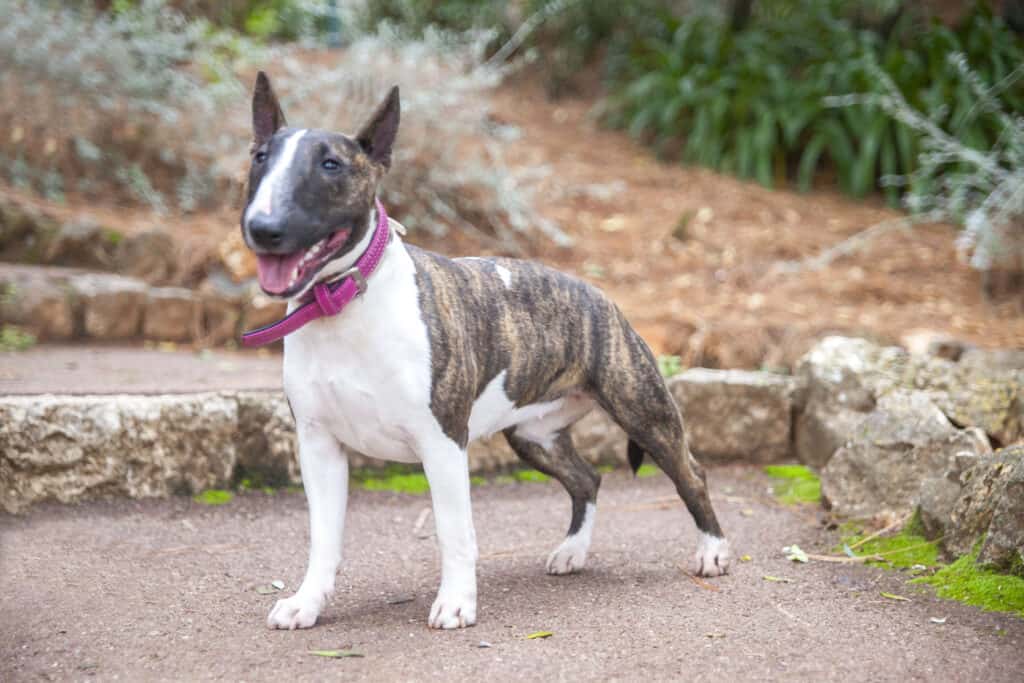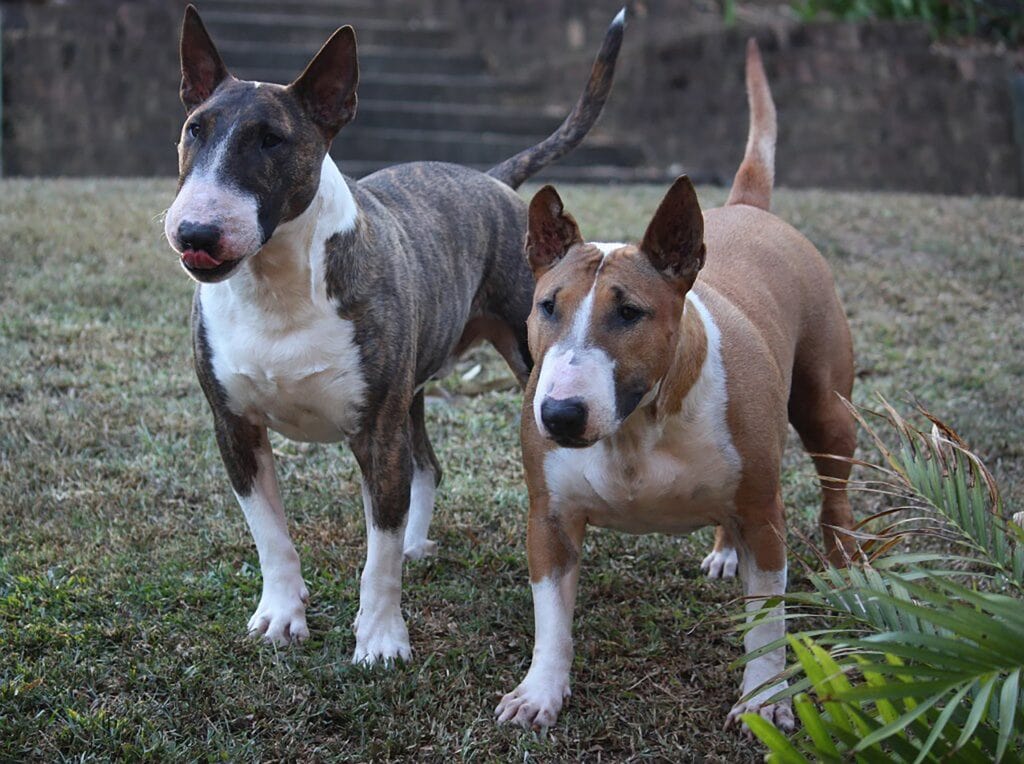The Miniature Bull Terrier, a smaller version of its standard counterpart, packs a lot of personality into its compact frame. With its distinctive egg-shaped head and muscular build, this terrier is known for its playful and affectionate nature. Despite its small size, the Miniature Bull Terrier possesses a robust spirit and makes a devoted companion for those seeking a dynamic and charismatic four-legged friend.

| Category (Explanation) | Breed Information |
|---|---|
| Year of Breed Conception | 19th century |
| Country of Origin | England |
| Weight (lbs & kg) (Male) | 24-33 lbs (11-15 kg) |
| Weight (lbs & kg) (Female) | 20-30 lbs (9-14 kg) |
| Coat Type | Short, dense, and smooth coat |
| Color Variations | White with markings |
| Shedding Level (Low, Moderate, High) | Low to Moderate |
| Height (cm & in) | 10-14 inches (25-36 cm) |
| Breed Size | Small |
| Trainability (Low, Moderate, High) | Moderate |
| Mental Needs (Low, Moderate, High) | Moderate |
| Intelligence Level (Low, Moderate, High) | Moderate |
| Energy Level (Low, Moderate, High) | Moderate to High |
| Agility (Low, Moderate, High) | High |
| Loyalty (Low, Moderate, High) | High |
| Playfulness (Low, Moderate, High) | High |
| Exercise Needs | Regular exercise and mental stimulation |
| Guarding Proficiency (Low, Moderate, High) | Moderate |
| Sociability with Children (Low, Moderate, High) | Moderate |
| Barking Level (Low, Moderate, High) | Moderate |
| Digging Tendency (Low, Moderate, High) | Moderate |
| Destructive Behavior (Low, Moderate, High) | Moderate |
| Drooling Level (Low, Moderate, High) | Low |
| Obedience Level (Low, Moderate, High) | Moderate |
| Apartment Friendly (Yes/No) | Can adapt to apartment living with sufficient exercise |
| Inherent Prey Drive | Moderate |
| Physical Risk to Others (Low, Moderate, High) | Low |
| Travel Fatality Risk (Low, Moderate, High) | Low |
| Allergen Potential | Low |
| Health Concerns (List of Common Health Concerns) | Deafness, Patellar Luxation, Heart Issues |
| Average Life Expectancy (Life Expectancy in Years) | 11-14 years |
Woof Mastery is reader supported and our articles may contain affiliate links.
Instead of running third party ads that we have no control of we only use links from high-quality companies we are directly partnered with. Making use of these links come at no cost to you our reader, and in many cases have the extra benefit of discounted rates or sign up bonuses.
If you’re interested you can read more about our affiliate policy here.
We appreciate your support and always insure that the products and services we recommend are high-quality, helpful and relevant to the subject at hand!
The Miniature Bull Terrier’s history is closely linked to its larger counterpart, the Bull Terrier. Developed in 19th-century England, the Miniature Bull Terrier was created by selectively breeding smaller individuals within the Bull Terrier breed. Originally used for ratting and as a fashionable companion, it gained popularity for its distinctive appearance, including the signature egg-shaped head. Over time, the Miniature Bull Terrier has become a beloved pet, appreciated for its playful nature, loyalty, and dynamic personality.

The Miniature Bull Terrier is special for its compact size and dynamic personality. Recognized for its distinctive egg-shaped head, this breed exudes charm and playfulness. What sets it apart is its ability to pack a punch of energy and affection in a small package. The Miniature Bull Terrier’s loyalty and spirited nature make it a special and engaging companion, offering a delightful mix of courage and affection to those who welcome it into their homes.
The Miniature Bull Terrier’s traditional role is closely linked to its larger counterpart, the Bull Terrier. Developed in 19th-century England, it was selectively bred for ratting and as a fashionable companion. Known for its distinctive egg-shaped head, the Miniature Bull Terrier gained popularity for its playful nature. Today, it continues its traditional role as a beloved pet, appreciated for its small size and dynamic personality. The Miniature Bull Terrier’s traditional role showcases its ability to bring joy and entertainment to households as a lively and affectionate companion.
Miniature Bull Terriers are known for their compact size and dynamic personalities. Recognized for their distinctive egg-shaped heads, they exude charm and playfulness. These terriers are loyal and spirited, often described as affectionate and energetic. Miniature Bull Terriers form strong bonds with their families and showcase a delightful mix of courage and affection. Despite their small stature, they possess a dynamic and outgoing nature. With proper training and socialization, they become engaging and loving companions, bringing joy and entertainment to households around the world.
Miniature Bull Terriers are known for their dynamic and affectionate temperament. Despite their small size, they possess a lively and playful nature. Early training and socialization are crucial to manage their energy levels. Miniature Bull Terriers form strong bonds with their families and are typically affectionate companions. Supervision is recommended, especially around other dogs, as they may not always get along, particularly with those of the same sex. With consistent training and positive reinforcement, Miniature Bull Terriers develop into engaging and loving family members, showcasing a spirited and well-balanced temperament.
Miniature Bull Terriers are small, compact dogs with a muscular and well-balanced build. They have a distinct egg-shaped head, small eyes, and erect ears. The breed is known for its straight and glossy coat, which comes in various colors, including white, brindle, fawn, red, or a combination of these. Miniature Bull Terriers have a straight back, a high-set tail, and a brisk, confident gait. Despite their small size, they convey a sense of strength, agility, and playfulness.
Miniature Bull Terriers come in various color variations, adding to their bold and distinctive appearance. The most common color variations for Miniature Bull Terriers include:
Miniature Bull Terriers can have various coat patterns, including white, brindle, fawn, red, or a combination of these. The breed’s coat is short, smooth, and glossy, emphasizing its muscular and well-proportioned build. Miniature Bull Terriers may have markings or patches, and variations in coat pattern contribute to their unique and playful appearance. The white coat is often the dominant color, and the breed’s lively expression and distinctive head shape make it easily recognizable regardless of coat pattern.
Miniature Bull Terriers have a low shedding level. Their short, smooth coat sheds minimally, and regular grooming is essential to maintain coat health. Brushing the coat once or twice a week helps remove loose fur and prevents matting. While Miniature Bull Terriers are not heavy shedders, grooming practices are important for the well-being of their coat.
Miniature Bull Terriers have a short, smooth coat that is relatively low-maintenance. Grooming practices for this breed include:
Brushing: Regular brushing with a soft bristle brush helps remove loose hair and keeps their coat shiny. This can be done about once or twice a week.
Bathing: Miniature Bull Terriers typically do not require frequent baths. Bathing them as needed, using a mild dog shampoo, is sufficient to keep them clean.
Ears: Check and clean their ears regularly to prevent wax buildup or infections. Use a damp cotton ball or a veterinarian-recommended ear cleaning solution.
Nails: Keep their nails trimmed to a comfortable length to prevent discomfort and maintain proper foot health.
Teeth: Dental hygiene is important. Brush their teeth regularly with a dog-friendly toothbrush and toothpaste. Dental chews or toys can also contribute to oral health.
Eye Care: Monitor their eyes for signs of irritation or discharge. If necessary, use a damp cloth to clean around the eye area.
Miniature Bull Terriers have a moderate to high activity level. These muscular dogs enjoy regular exercise, including walks, playtime, and activities that engage them physically. Providing mental stimulation through training sessions and interactive toys is important for their well-being. Miniature Bull Terriers may excel in various dog sports and activities, making them suitable for owners who enjoy an active lifestyle.
Miniature Bull Terriers possess intelligence wrapped in confidence and spirit. Their energetic nature is complemented by problem-solving skills and a quick learning pace. Positive reinforcement training methods are effective in bringing out their responsive nature. Providing mental challenges and physical activities ensures they stay mentally stimulated and well-behaved.
Miniature Bull Terriers require mental stimulation to keep them engaged. Activities like puzzle toys, interactive games, and training exercises challenge their minds. Regular social interaction is important, as they are social dogs. Obedience training not only provides mental stimulation but also strengthens the bond with their owners. Routine, affection, and a safe environment contribute to their overall mental well-being.
Enter The Woof Mastery

Before bringing a Miniature Bull Terrier into your home, consider the following:
Miniature Bull Terriers, known for their confidence, may pose a risk if not properly trained and socialized. Early training and consistent socialization can help manage their behavior, ensuring they are comfortable around people and other pets. Owners should be responsible and aware of their dog’s interactions in various settings.
Miniature Bull Terriers, known for their confidence, can be good companions for older children. Supervision is important, especially due to their energy levels. Proper socialization from an early age is essential to ensure they interact well with children. Obedience training can help curb any exuberant behavior, and they may form strong bonds with the kids in their family.
Miniature Bull Terriers may have varied responses to water. Some may enjoy swimming, while others may not be as comfortable. As with any dog, introduce them to water gradually and observe their comfort level. Use a canine life vest if swimming in open water or deep pools to ensure their safety.
Remember that Miniature Bull Terrier puppies, like all puppies, are eager to please and learn. Positive and consistent training practices will help them become well-behaved, obedient, and happy adult dogs. Building a strong and trusting bond with your puppy through training is a rewarding experience for both you and your canine companion.
Miniature Bull Terriers may be vocal and expressive, but they are not generally known for excessive barking. Early training and socialization play a significant role in managing their behavior, including barking tendencies.
Miniature Bull Terriers thrive in homes with active owners who can provide regular exercise and play. They are adaptable to various living conditions, including apartments, but they need mental stimulation. Socialization is important to prevent aggressive behavior. Positive reinforcement training is effective in shaping their behavior.
Traveling with Miniature Bull Terriers requires considerations for their size and energy levels. Use a suitable travel crate or restraint for their safety. Plan for breaks during the journey for stretching and bathroom breaks. Address any potential anxiety through positive associations with travel and familiar items. Choose airlines with policies accommodating their size if flying and comply with crate requirements for air travel safety.
Miniature Bull Terriers, like all breeds, may be susceptible to certain health issues. While not all individuals will experience these problems, it’s important for Miniature Bull Terrier owners to be aware of potential health risks and work with veterinarians to maintain their pets’ well-being. Common health concerns in Miniature Bull Terriers include:
Owners should prioritize regular veterinary check-ups, preventive care, and a balanced diet to support the health and well-being of Miniature Bull Terriers.
Proper nutrition is crucial for the health and well-being of Miniature Bull Terriers. Here are some nutritional habits and best practices to consider for this breed:
Breed-Specific Laws (BSL): Miniature Bull Terriers may be subject to breed-specific laws (BSL) in certain areas. These laws are often enacted at the local or municipal level and can vary widely from one jurisdiction to another.
Types of Restrictions: The specific restrictions imposed on Miniature Bull Terriers under BSL can include mandatory spaying/neutering, special licensing, liability insurance requirements, muzzling in public, and, in some cases, bans on ownership. The severity of these restrictions depends on local regulations.
Rationale for BSL: BSL is typically implemented based on concerns about public safety and perceived risks associated with specific breeds, often due to incidents involving dog attacks. While Miniature Bull Terriers are not inherently aggressive, they can be affected by BSL due to their physical resemblance to breeds that are sometimes included in these laws.
Controversy: It’s important to note that BSL is a controversial topic. Critics argue that it unfairly targets breeds rather than addressing individual dog behavior and that responsible ownership and training should be emphasized instead of breed-specific restrictions.
Local Regulations: To determine if there are breed-specific laws or restrictions regarding Miniature Bull Terriers in your area, you should check with your local animal control or government authorities. Be aware of and comply with any local regulations to ensure that you are in compliance with the law while owning a Miniature Bull Terrier.
Woof Mastery is reader supported and our articles may contain affiliate links.
Instead of running third party ads that we have no control of we only use links from high-quality companies we are directly partnered with. Making use of these links come at no cost to you our reader, and in many cases have the extra benefit of discounted rates or sign up bonuses.
If you’re interested you can read more about our affiliate policy here.
We appreciate your support and always insure that the products and services we recommend are high-quality, helpful and relevant to the subject at hand!
Myth 1: Miniature Bull Terriers are Aggressive
Myth 2: They are Not Good with Children
Myth 3: They are Too Energetic for Apartment Living
Myth 4: They are Difficult to Train
Myth 5: They are Prone to Excessive Barking
Myth 6: They Don’t Get Along with Other Pets
Myth 7: They Require Excessive Grooming
Myth 8: They Need Intense Exercise All the Time
Myth 9: They are Not Affectionate
Myth 10: They are All the Same in Temperament
Understanding the true characteristics of Miniature Bull Terriers helps promote responsible ownership and a positive relationship with these energetic and affectionate dogs.
Famous Miniature Bull Terrier examples include:
Eddie: Eddie, the dog from the television show “Frasier,” was portrayed by a Miniature Bull Terrier named Moose. Moose gained fame for his role and became one of the most recognized dogs in the entertainment industry.
The Miniature Bull Terrier is culturally significant as a breed with a unique appearance and spirited personality. Recognized for their muscular build and “egg-shaped” head, Miniature Bull Terriers have become popular as companions. Their appearance in popular media, including films and advertisements, contributes to their cultural appeal. Miniature Bull Terriers are symbols of strength and tenacity, finding a place as beloved family members and energetic companions.
The Miniature Bull Terrier is culturally significant as a breed with a unique appearance and spirited personality. Recognized for their muscular build and “egg-shaped” head, Miniature Bull Terriers have become popular as companions. Their appearance in popular media, including films and advertisements, contributes to their cultural appeal. Miniature Bull Terriers are symbols of strength and tenacity, finding a place as beloved family members and energetic companions.
Miniature Bull Terriers, like many terrier breeds, have faced specific challenges and considerations. Some of the notable challenges include:
The Miniature Bull Terrier is a smaller version of the Bull Terrier. Contributing breeds may include:
Miniature Bull Terriers, with their distinctive appearance and lively personality, add a touch of charm to every home. Their small size and affectionate nature make them ideal companions for families and individuals alike. Their adaptability to various living conditions allows them to fit seamlessly into urban and suburban settings. Engaging in interactive play and providing them with the attention they love strengthens the special bond they share with their families, making them cherished members of the household.